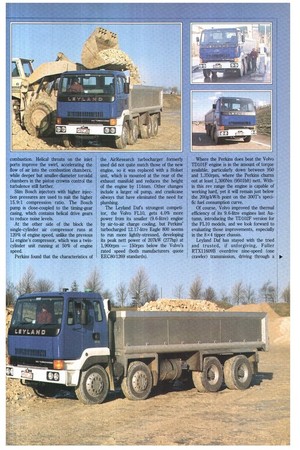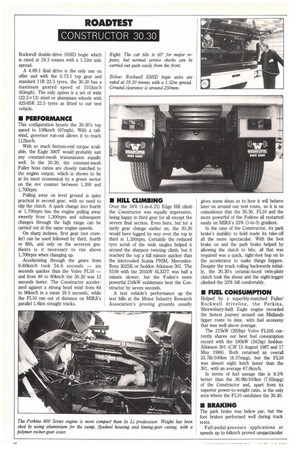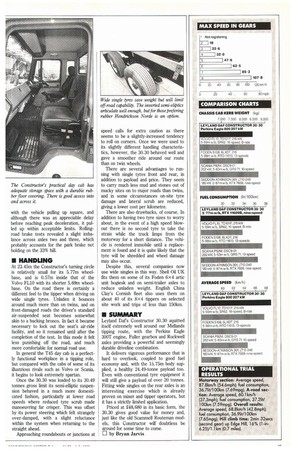Leyland Daf's Constructor 30.30 is the fastest vehicle yet tested
Page 36

Page 37

Page 38

Page 39

If you've noticed an error in this article please click here to report it so we can fix it.
round our Midlands tipper route. It also offers above-average fuel consumption and a healthy payload.
• Daf Trucks' absorbtion of Leyland last April rather spoiled the party for Perkins, which had developed its all-new Eagle 800 engine range especially for Leyland vehicles, apart from some that were earmarked for Foden.
Nonetheless, an Eagle 300T-powered Constructor 30.30 eight-wheeled tipper debuted at Tipcon '87, and since then, as the Leyland Daf organisation has taken shape, its 8x4 sales have gradually increased as the 800 Series engine has superseded the earlier Li Eagle range.
Of the ten 30-tonners currently available from Leyland Daf, two have variations of the turbocharged Eagle 800 engine. The Constructor 30.27 uses the 198kW (265hp) 265T; we have now tested the 30.30, powered by the higherpowered 300T unit. The question facing us was whether or not the increase in power and performance would harm the Constructor's fuel economy.
There are several major differences between this latest and most-powerful rigid of the Leyland Daf line-up, and the last Leyland 30.49-tonne tipper we tested (CM 30 May 1981).
Engine outputs are poles apart: up from the 156kW (209hp) of the TL11A engine that was used in the old Scammell Constructor 30.21, to the 207kW of the Perkins 800-3001.
Unusually, this 30.30 has been con
verted, quite literally, into an eightwheeler by fitting wide single aluminium whels on the rear bogie axles. This option lowers the unladen weight of the chassis cab by some 367kg, and saves about £75 in initial tyre costs.
• DRIVEUNE
Perkins' 800 range is a new family of engines that will eventually replace the existing Li models. The new Eagles, which span the 198-261kW (265-359hp) gross power range were introduced in November 1986 for the four-axled and two/three-a3ded tractive unit markets.
The 300T embodies all of the Eagle 800 design changes, the most important of which is the re-vamped cylinder head that is claimed to give better breathing and combustion. Helical throats on the inlet ports improve the swirl, accelerating the flow of air into the combustion chambers, while deeper but smaller-diameter toroidal chambers in the piston crowns control the turbulence still further.
Slim Bosch injectors with higher injection pressures are used to suit the higher 15.9:1 compression ratio. The Bosch pump is close-coupled to the timing-gear casing, which contains helical drive gears to reduce noise levels.
At the other side of the block the single-cylinder air compressor runs at 120% of engine speed, unlike the previous Li engine's compressor, which was a twincylinder unit running at 50% of engine speed.
Perkins found that the characteristics of the AirResearch turbocharger formerly used did not quite match those of the new engine, so it was replaced with a Holset unit, which is mounted at the rear of the exhaust manifold and reduces the height of the engine by 114mrn. Other changes include a larger oil pump, and crankcase oilways that have eliminated the need for plumbing.
The Leyland Dafs strongest competitor, the Volvo FL10, gets 4.0% more power from its smaller (9.6-litre) engine by air-to-air charge cooling, but Perkins' turbocharged 12.17-litre Eagle 800 seems to run more lightly-stressed, developing its peak nett power of 207kW (27'711p) at 1,900rpm — 150rpm below the Volvo's rated speed (both manufacturers quote EEC80/1269 standards). Where the Perkins does beat the Volvo TD101F engine is in the amount of torque available, particularly down between 950 and 1,350rpm, where the Perkins churns out at least 1,300Nm (9501bft) nett. Within this rev range the engine is capable of working hard, yet it will remain just below the 200g/kW/h point on the 300T's specific fuel consumption curve.
Of course, Volvo improved the thermal efficiency of its 9.6-litre engines last Autumn, introducing the TD102F version for the FL10 models, and we look forward to evaluating those improvements, especially in the 8x4 tipper chassis.
Leyland Oaf has stayed with the tried and trusted, if unforgiving, Fuller RTX11609B overdrive nine-speed (one crawler) transmission, driving through a Rockwell double-drive SSHD bogie which is rated at 19.3 tonnes with a 1.52m axle spread.
A 4.89:1 final drive is the only one on offer and with the 0.73:1 top gear and standard 11R 22.5 tyres, the 30.30 has a maximum geared speed of 101km/h (63mph). The only option is a set of wide (22.5 x 13) steel or aluminium wheels with 425/65R 22.5 tyres as fitted to our test vehicle.
• PERFORMANCE
This configuration boosts the 30.30's top speed to 1081un/h (67mph). With a tailwind, governor run-out allows it to reach 112km/h.
With so much bottom-end torque available, the Eagle 300T would probably suit any constant-mesh transmission equally well. In the 30.30, the constant-mesh Fuller boxs ratios are closely matched to the engine output, which is shown to be at its most economical by a green sector on the rev counter between 1,300 and 1, 70Orpm.
Pulling away on level ground is quite practical in second gear, with no need to slip the clutch. A quick change into fourth at 1,700rnm has the engine pulling away sweetly from 1,300rpm and subsequent changes through the high range can be carried out at the same engine speeds.
On sharp inclines, first gear (not crawler) can be used followed by third, fourth or fifth, and only on the severest gradients is it necessary to run above 1,700rpm when changing up.
Accelerating through the gears from 0-80km/h took 54.6 seconds — six seconds quicker than the Volvo FL10 — and from 48 to 80km/h the 30.30 was 12 seconds faster. The Constructor accelerated against a strong head wind from 64 to 961un/h in a mean 39.5 seconds, while the FL10 ran out of distance on MIRA's parallel 1.6km straight tracks.
• HILL CLIMBING
Over the 16% (1-in-6.25) Edge Hill climb the Constructor was equally impressive, being happy in third gear for all except the severe final section. Even here, but for a tardy gear change earlier on, the 30.30 would have lugged its way over the top in third at 1,350rpm. Certainly the reduced tyre scrub of the wide singles helped it around the sharpest twisting climb, but it reached the top a full minute quicker than the intercooled Scania P92M, MercedesBenz 3025K or Seddon Atkinson 301. The S108 with the 201kW 6LXDT was half a minute slower, but the Foden's more powerful 216kW stablemate beat the Constructor by seven seconds.
A test vehicle's performance up the test hills at the Motor Industry Research Association's proving grounds usually gives some ideas as to how it will behave later on around our test route, so it is no coincidence that the 30.30, FL10 and the more powerful of the Fodens all restarted easily on MIRA's 33% (1-in-3) gradient.
In the case of the Constructor, its park brake's inability to hold made its take-off all the more spectacular. With the foot brake on and the park brake helped by allowing the clutch to bite, all that was required was a quick, right-foot hop on to the accelerator to make things happen. Despite the truck rolling backwards initially, the 30.30's ceramic-faced twin-plate clutch took the abuse and the eight-legger climbed the 33% hill comfortably.
• FUEL CONSUMPTION
Helped by a superbly-matched Fuller/ Rockwell driveline, the Perkins, Shrewsbury-built Eagle engine recorded the fastest journey around our Midlands tipper route to date, with fuel economy that was well above average.
The 215kW (292hp) Volvo FL105 currently shares our best fuel consumption record with the 180kW (241hp) SeddonAtkinson 301 (CM 13 August 1987 and 17 May 1986). Both returned an overall 33.71it/100km (8.37mpg), but the FL10 was almost eight km/h faster than the 301, with an average 67.6Iun/h.
In terms of fuel useage this is 8.5% better than the 36.91it/100km (7.65mpg) of the Constructor and, apart from its superior power-to-weight ratio, is the only area where the FLIO outshines the 30.30.
• BRAKING
The park brake was below par, but the foot brakes performed well during track tests.
Full-pedal-pressure applications at speeds up to 64krn/li proved unsp,ectacular with the vehicle pulling up square, and although there was an appreciable delay before reaching peak deceleration, it pulled up within acceptable limits. Rollingroad brake tests revealed a slight imbalance across axles two and three, which probably accounts for the park brake not holding on the 33% hill.
• HANDUNG
At 23.45m the Constructor's turning circle is relatively small for its 5.77m wheelbase, and is 0.57m inside that of the Volvo FL10 with its shorter 5.69m wheelbase. On the road there is certainly a different feel to the tipper when driving on wide single tyres. Unladen it bounces around much more than on twins, and on frost-damaged roads the driver's standard air-suspended seat becomes somewhat akin to a bucking bronco. In fact it became necessary to lock out the seat's air-ride facility, and so it remained until after the completion of the test. In this mode it felt less punishing off the road, and much more comfortable for normal road use.
In general the T45 day cab is a perfectly functional workplace in a tipping role, but compared with the cabs of some of its illustrious rivals such as Volvo or Scania, it begins to look extremely spartan.
Once the 30.30 was loaded to its 30.49 tonnes gross limit its semi-elliptic suspension behaved in a much more domesticated fashion, particularly at lower road speeds where reduced tyre scrub made manoeuvring far crisper. This was offset by its power steering which felt strangely over-damped, with a slight reluctance within the system when returning to the straight ahead.
Approaching roundabouts or junctions at speed calls for extra caution as there seems to be a slightly-increased tendency to roll on corners. Once we were used to its slightly different handling characteristics, however, the 30.30 behaved well and gave a smoother ride around our route than on twin wheels.
There are several advantages to running with single tyres front and rear, in addition to payload and price. They seem to carry much less mud and stones out of mucky sites on to major roads than twins, and in some circumstances on-site tyre damage and lateral scrub are reduced, giving a lower cost per kilometre.
There are also drawbacks, of course. In addition to having two tyre sizes to worry about, in the event of a high speed blowout there is no second tyre to take the strain while the truck limps from the motorway for a short distance. The vehicle is rendered immobile until a replacement is found and it is quite likely that the tyre will be shredded and wheel damage may also occur.
Despite this, several companies now use wide singles in this way. Shell Oil UK fits them on some of its Foden 6x4 artic unit bogiesk and on semi-trailer axles to reduce unladen weight. English China Clay's Cornish fleet also uses them on about 40 of its 8x4 tippers on selected site work and trips of less than 150km.
• SUMMARY
Leyland Dafs Constructor 30.30 aquitted itself extremely well around our Midlands tipping route, with the Perkins Eagle 300T engine, Fuller gearbox and Rockwell axles providing a powerful and seemingly durable driveline combination.
It delivers vigorous performance that is hard to overlook, coupled to good fuel economy and, with the 15.75m body supplied, a healthy 24.49-tonne payload too. Even with conventional tyre equipment it will still give a payload of over 20 tonnes. Fitting wide singles on the rear axles is an interesting exercise which is already proven on mixer and tipper operators, but it has a strictly limited application.
Priced at £48,680 in its basic form, the 30.30 gives good value for money and, just like the old Scarnmell Routeman models, this Constructor willdoubtless be around for some time to come.
0 by Bryan Jarvis
































































































































